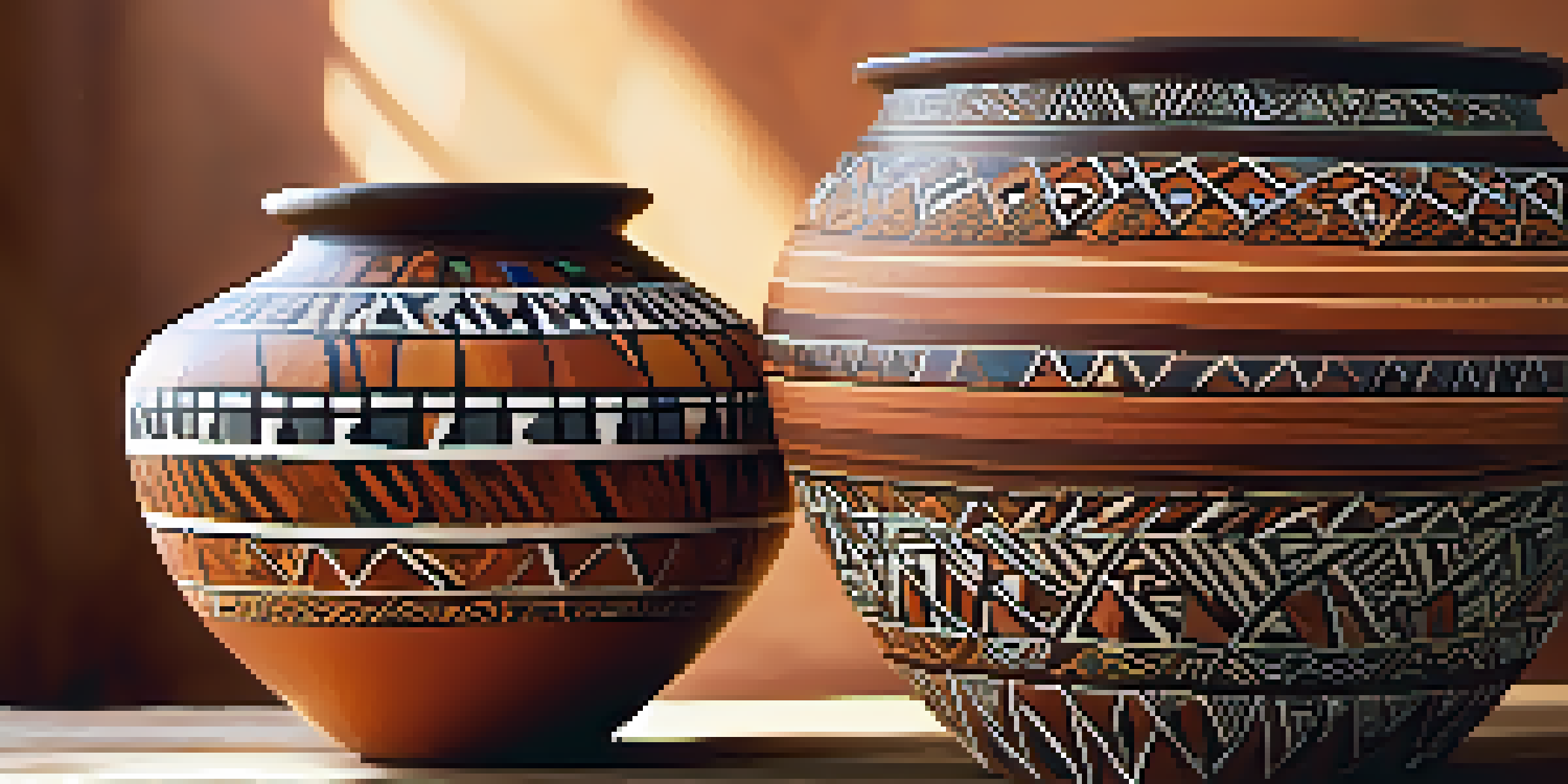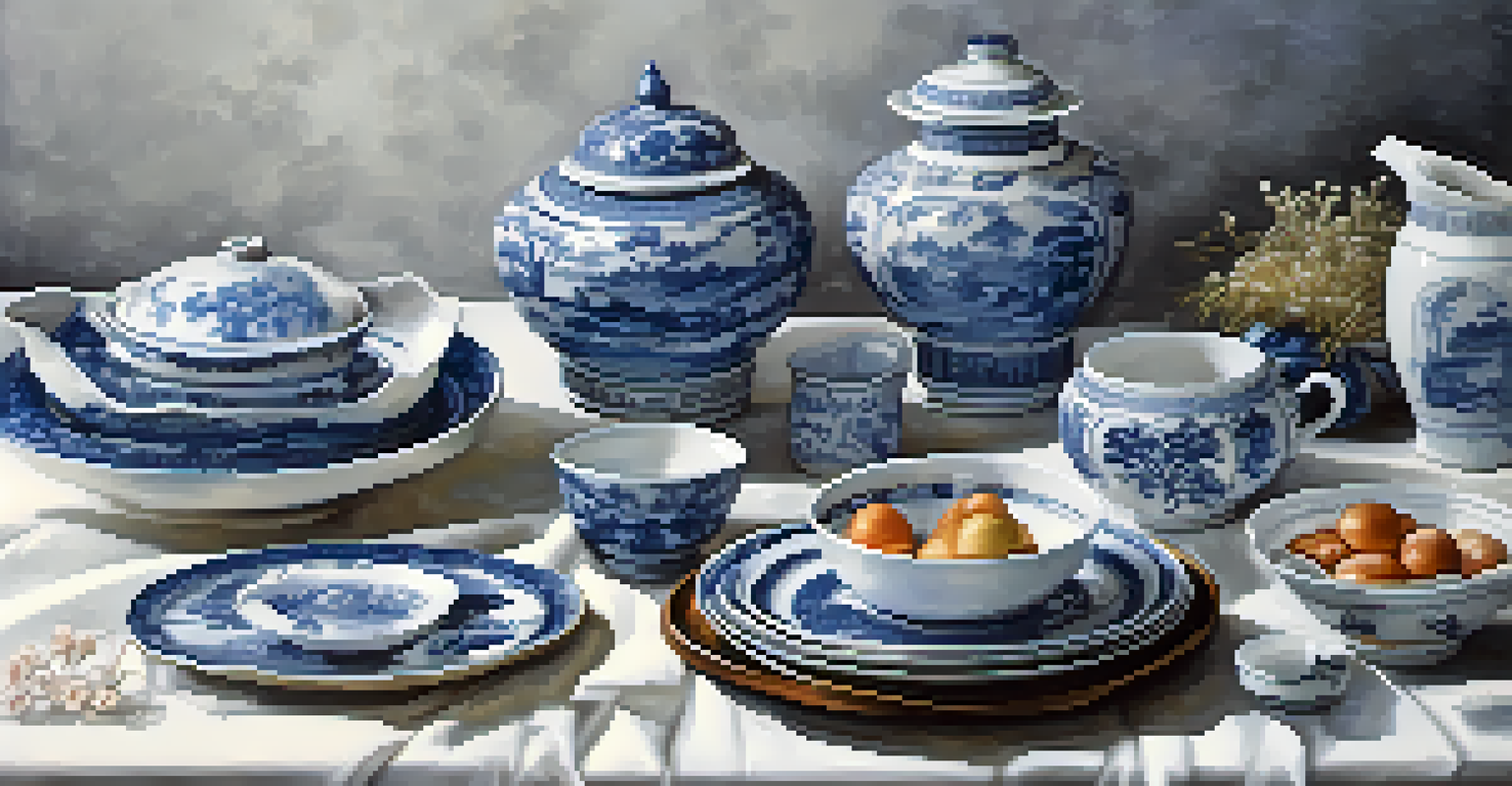Pottery in Different Cultures: A Global Perspective

The Ancient Roots of Pottery: A Universal Craft
Pottery is one of humanity's oldest crafts, tracing back over 20,000 years. Early civilizations used clay to create functional items like pots and bowls, essential for daily life. This ancient practice not only provided utility but also served as a canvas for artistic expression, reflecting the culture and values of the people who created it.
Pottery is a way of life, not just a craft.
For instance, the early potters of Mesopotamia developed intricate designs that told stories of their gods and daily activities. Similarly, the Chinese were known for their porcelain, which symbolized purity and elegance. As communities evolved, so did their pottery techniques, leading to regional styles that highlight the diversity in this art form.
Today, pottery continues to be a vital part of cultural identity, linking modern communities to their ancestors. Whether it's a simple earthenware pot or a finely crafted vase, each piece carries a legacy that connects us to the past.
Cultural Significance of Pottery in African Traditions
In many African cultures, pottery is not just a craft but a vital cultural expression. Each region boasts unique styles and techniques, often passed down through generations. For example, the Ndebele people of South Africa are renowned for their vibrant, geometric pottery that reflects their rich heritage and social status.

Pottery also plays a crucial role in rituals and ceremonies. In various communities, clay pots are used in marriage ceremonies, funerals, and religious offerings, symbolizing fertility and life. This connection between pottery and spirituality emphasizes its importance beyond mere functionality.
Pottery as Cultural Identity
Pottery serves as a vital expression of cultural identity, linking modern communities to their ancestors through unique styles and techniques.
Moreover, the revival of traditional pottery techniques in Africa has sparked interest in sustainable practices. Artisans are increasingly using locally sourced materials, blending ancient methods with contemporary designs, showcasing the resilience and adaptability of cultural traditions.
Asian Pottery: A Blend of Art and Functionality
Asia has a rich history of pottery that merges artistry with practicality. Countries like Japan and China are famous for their ceramics, which often serve both decorative and utilitarian purposes. For instance, Japanese Raku pottery is celebrated for its unique firing process, resulting in distinctive textures and colors that make each piece one-of-a-kind.
Art is the most beautiful of all lies.
Chinese porcelain, on the other hand, is synonymous with luxury and refinement. The intricate blue-and-white designs often depict scenes from nature or mythology, making them highly sought after worldwide. This blend of artistry and functionality showcases the cultural values and craftsmanship that define Asian pottery.
Additionally, pottery in Asia often reflects philosophical and aesthetic ideals, such as simplicity and harmony with nature. This connection to broader cultural concepts enriches the art form, making it a fascinating study of how societies interpret their environment through clay.
The Role of Pottery in Indigenous Cultures
Indigenous cultures around the world hold pottery in high esteem, often viewing it as an extension of their identity. For many Native American tribes, pottery is not merely a craft but a living tradition that embodies their history and beliefs. Each piece, from functional bowls to ceremonial items, tells a story that connects the maker to their ancestors.
For example, the Pueblo people of the Southwestern United States are known for their distinctive clay pottery, often adorned with intricate designs that represent nature and spirituality. These vessels are used in various ceremonies and are cherished as cultural artifacts, illustrating the deep-rooted connection between art and cultural identity.
Modern Pottery Revitalization
Today's pottery artists are blending traditional methods with contemporary aesthetics, fostering a global community and promoting sustainable practices.
In recent years, efforts have been made to revive traditional pottery techniques among Indigenous communities, fostering a sense of pride and continuity. This movement not only preserves their heritage but also promotes cultural resilience in the face of modernization.
Pottery in European Cultures: A Historical Journey
Europe boasts a diverse range of pottery styles, each reflecting the region's history and social dynamics. From the ancient Greeks and Romans, who produced beautifully decorated amphorae, to the iconic Delftware of the Netherlands, European pottery has evolved significantly over centuries. Each piece tells a tale of the era's artistic trends and cultural influences.
The Renaissance period marked a significant turning point in European ceramics, where potters began to embrace realism and intricate designs. The introduction of new materials and techniques, such as tin-glazing, led to a flourishing of pottery art that captivated collectors and art lovers alike. These innovations paved the way for modern ceramic art.
Today, pottery in Europe continues to thrive, with contemporary artists experimenting with traditional methods while pushing the boundaries of design. This blend of old and new not only preserves the rich history of European pottery but also ensures its relevance in the modern art scene.
Modern Pottery: A Fusion of Tradition and Innovation
In today's world, pottery is experiencing a renaissance, with artists blending traditional techniques with modern aesthetics. Many potters are exploring new forms, glazing methods, and firing techniques, resulting in innovative works that challenge conventional boundaries. This fusion of old and new not only revitalizes the craft but also appeals to contemporary audiences.
Social media platforms have played a pivotal role in this pottery revival, allowing artists to showcase their work globally. Pottery enthusiasts can now connect, share ideas, and discover new trends from around the world. This sense of community fosters creativity and encourages collaboration among artists, leading to exciting new discoveries in the field.
Therapeutic Benefits of Pottery
Engaging in pottery making offers therapeutic benefits, promoting mindfulness, self-expression, and mental well-being among participants.
Moreover, the growing interest in sustainable practices has led many potters to prioritize eco-friendly materials and methods. By embracing sustainability, modern pottery not only reflects current values but also honors the age-old traditions that have shaped this beautiful craft.
The Therapeutic Benefits of Pottery Making
Beyond its cultural significance, pottery making offers a range of therapeutic benefits. Engaging in this hands-on craft can be incredibly meditative, providing a much-needed escape from the hustle and bustle of daily life. The process of shaping clay, whether on a wheel or by hand, encourages mindfulness and fosters a deep connection with the material.
Furthermore, pottery classes have become popular as a form of stress relief and self-expression. Participants often report feelings of joy and fulfillment as they create something tangible from raw materials. This creative outlet not only boosts mental well-being but also fosters a sense of community among participants.

As more people discover the joys of pottery, workshops and studios are popping up everywhere, inviting individuals of all skill levels to explore their creativity. This resurgence in pottery making not only preserves the craft but also highlights its role in promoting mental health and well-being.